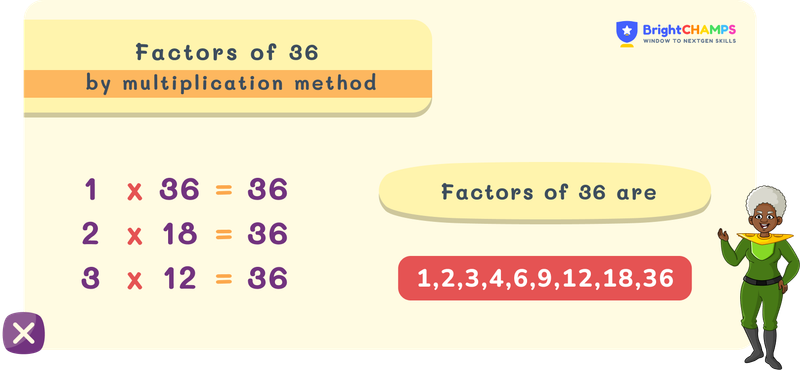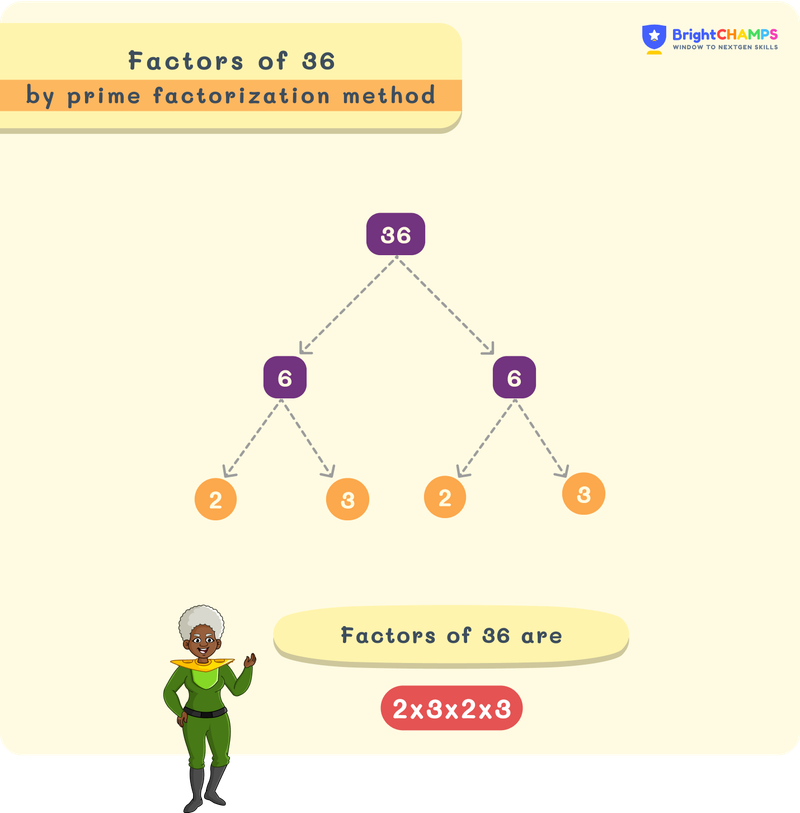Summarize this article:
 1122 Learners
1122 LearnersLast updated on December 15, 2025
Factors of 36

Factors are those numbers whose dividend is divisible by quotient completely. The factors of 36 are whole numbers.

What are the Factors of 36?
Factors of 36 will divide 36 completely. These are multiplied in pairs to get 36 as the product.
1, 2, 3, 4, 6, 9, 12, 18 and 36 the factors of 36.
Negative Factors: These are negative counterparts of the positive factors.
Negative factors: -1, -2, -3, -4, -6, -9, -12, -18 and -36
Prime Factors: Prime factors are the prime numbers when multiplied together, giving 36 as the product.
Prime factors: 2 and 3
Prime Factorization: Prime factorization involves breaking 36 into its prime factors.
It is expressed as 22 × 32
sum of the factors of 36 :The sum refers to the number we get by adding the factors of the given number.
Sum = 1+2 + 3 + 4 + 6 + 9 + 12 + 18 + 36 = 91
The factors of 36 can be written as shown in the table given below:
| Factor Type | Values |
| Positive Factors of 36 | (1, 2, 3, 4, 6, 9, 12, 18, 36) |
| Negative Factors of 36 | (-1, -2, -3, -4, -6, -9, -12, -18, -36) |
| Prime Factors of 36 | (2, 3) |
| Prime Factorization of 36 | 22 × 32 |
| Sum of factors of 36 | -91 |

How to Find the Factors of 36?
There are different methods to find the factors of 36.
Methods to find the factors of 36:
- Multiplication Method
- Division Method
- Prime Factor and Prime Factorization

Finding Factors Using Multiplication Method
The multiplication method involves finding pairs of numbers that give 36 as the product. Steps are given below:
Step 1: Find the pair of numbers whose product is 36.
Step 2: The factors are those numbers, when multiplied, give 36.
Step 3: Make a list of numbers whose product will be 36
A list of numbers whose products are 36 is given below:
- 1 × 36 = 36
- 2 × 18 = 36
- 3 × 12 = 36
- 4 × 9 = 36
- 6 × 6 = 36

Explore Our Programs



Finding Factors Using Division Method
The division method finds the numbers that fully divide the given number. Step-by-step process given below:
Step 1: Since every number is divisible by 1, both 1 and the number will always be its factors. Example: 36÷1 = 36
Step 2: Move to the next integer. Both divisor and quotient are the factors. Example: 36÷2 = 18, 36÷3 = 12 and so on. Here, 2 is the divisor and 18 is the quotient.


Prime Factors and Prime Factorization
- Multiplying prime numbers to get the given number as their product is called prime factors.
- Prime factorization is the process of breaking down the number into its prime factors.

Prime Factors of 36
Number 36 has only two prime factors.
Prime factors of 36: 2, 3
Steps to find the prime factors of 36:
Step 1: Divide 36 with the smallest prime number 2
36÷2 = 18
18÷2 = 9
Step 2: Take the next prime number, which is 3
9÷3 = 3
3÷3 = 1

Prime Factorization of 36
Prime Factorization breaks down the prime factors of 36.
Expressed as 22 × 32
Factor Tree of 36
The prime factorization is visually represented using the factor tree. It helps to understand the process easily.


Factor Pairs of 36
The factors of 36 can be written in both positive and negative pairs. The table below represents the factor pairs of 36, where the product of each pair of numbers is equal to 36.
Positive Pair Factors of 36:
| Factors | Positive Pair Factors |
| 1 × 36 = 36 | 1, 36 |
| 2 × 18 = 36 | 2, 18 |
| 3 × 12 = 36 | 3, 12 |
| 4 × 9 = 36 | 4, 9 |
| 6 × 6 = 36 | 6, 6 |
Since the product of two negative numbers is also positive, 36 also has negative pair factors.
Negative Pair Factors of 36:
| Factors | Negative Pair Factors |
| −1 × −36 = 36 | −1, −36 |
| −2 × −18 = 36 | −2, −18 |
| −3 × −12 = 36 | −3, −12 |
| −4 × −9 = 36 | −4, −9 |
| −6 × −6 = 36 | −6, −6 |

Common Mistakes and How to Avoid Them in Factors of 36
Mistakes can occur while finding the factors. Learn about the common mistakes that can occur. Solutions to solve the common mistakes are given below.

Examples on Factors of 36

Problem 1
What is the smallest prime factor of 36?

2 is the smallest prime factor
Explanation
2 has two factors, 1 and the number itself.

Problem 2
The sum of perfect square factors?

The sum is 50.
Explanation
1, 4, 9, and 36 are the perfect squares among the factors.
Add all the factors and the sum will be 50

Problem 3
A Costco store in Dallas receives 36 energy bars to pack equally into gift boxes for an NFL watch party. The manager wants to know all the possible ways the bars can be divided equally with no leftovers. What are all the factors of 36 that represent possible numbers of boxes?

1, 2, 3, 4, 6, 9, 12, 18, 36
Explanation
Factors are numbers that divide 36 exactly without leaving a remainder.
Checking each divisor of 36 gives the full list:
1×36, 2×18, 3×12, 4×9, and 6×6.
Each number in these pairs is a factor of 36.

Problem 4
A CVS pharmacy in Boston has 36 mg of a vitamin supplement. The pharmacist needs to divide it into equal doses for patients without splitting any dose. Which numbers can be used as equal doses (in mg)?

1, 2, 3, 4, 6, 9, 12, 18, 36
Explanation
Since the total amount is 36 mg, any number that divides 36 exactly can be used as a dose. All numbers that divide 36 with no remainder are its factors, so each factor represents a valid dose size.

Problem 5
A middle school in Chicago is preparing 36 science kits for students participating in an NBA-themed STEM event. Each classroom must receive the same number of kits. How many different classroom group sizes are possible?

9 possible group sizes
Explanation
The number of possible group sizes depends on how many ways 36 can be divided equally.
Since 36 has the factors 1, 2, 3, 4, 6, 9, 12, 18, and 36, there are 9 different ways to group the kits evenly.


FAQs on Factors of 36
1.What is the largest factor of 36?
2.Highest prime factor of 36
3.How do you express the prime factorization of 36?
4.List the positive pairs of 36
5.Can there be negative factors of 36?
6.How many factors does 36 have?
7.What is the smallest factor of 36?
8.Which factors of 36 add up to 13?
9.How many even factors does 36 have?
10.What are the odd factors of 36?
11.What is the sum of all the factors of 36?


Hiralee Lalitkumar Makwana
About the Author
Hiralee Lalitkumar Makwana has almost two years of teaching experience. She is a number ninja as she loves numbers. Her interest in numbers can be seen in the way she cracks math puzzles and hidden patterns.
Fun Fact
: She loves to read number jokes and games.


















